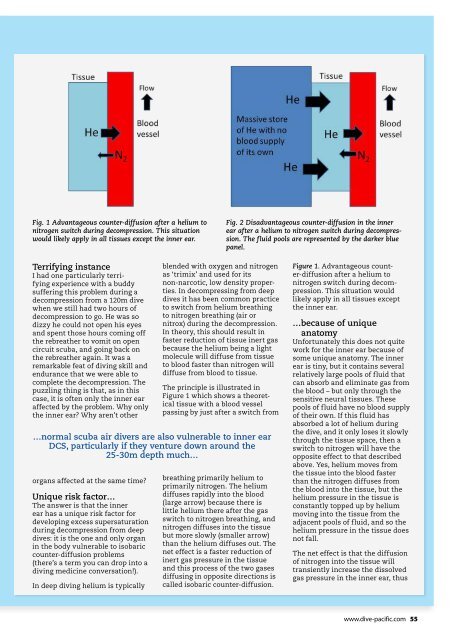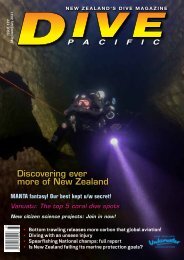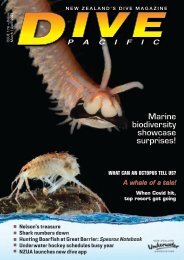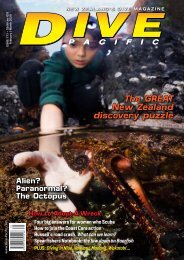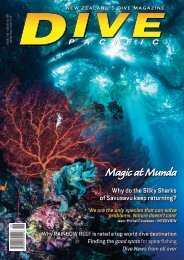Dive Pacific Iss 171 Oct- Nov 2019
New Zealand's dive magazine featuring in this issue: Shooting big sharks, up close; Spearfishing at night!; Remembering a great Kiwi dive pioneer, Wade Doak; Forgotten Vanuatu wreck's claim to fame; The invasive Lionfish - in depth, plus all our expert columnists
New Zealand's dive magazine featuring in this issue: Shooting big sharks, up close; Spearfishing at night!; Remembering a great Kiwi dive pioneer, Wade Doak; Forgotten Vanuatu wreck's claim to fame; The invasive Lionfish - in depth, plus all our expert columnists
You also want an ePaper? Increase the reach of your titles
YUMPU automatically turns print PDFs into web optimized ePapers that Google loves.
Fig. 1 Advantageous counter-diffusion after a helium to<br />
nitrogen switch during decompression. This situation<br />
would likely apply in all tissues except the inner ear.<br />
Fig. 2 Disadvantageous counter-diffusion in the inner<br />
ear after a helium to nitrogen switch during decompression.<br />
The fluid pools are represented by the darker blue<br />
panel.<br />
Terrifying instance<br />
I had one particularly terrifying<br />
experience with a buddy<br />
suffering this problem during a<br />
decompression from a 120m dive<br />
when we still had two hours of<br />
decompression to go. He was so<br />
dizzy he could not open his eyes<br />
and spent those hours coming off<br />
the rebreather to vomit on open<br />
circuit scuba, and going back on<br />
the rebreather again. It was a<br />
remarkable feat of diving skill and<br />
endurance that we were able to<br />
complete the decompression. The<br />
puzzling thing is that, as in this<br />
case, it is often only the inner ear<br />
affected by the problem. Why only<br />
the inner ear? Why aren’t other<br />
organs affected at the same time?<br />
Unique risk factor…<br />
The answer is that the inner<br />
ear has a unique risk factor for<br />
developing excess supersaturation<br />
during decompression from deep<br />
dives: it is the one and only organ<br />
in the body vulnerable to isobaric<br />
counter-diffusion problems<br />
(there’s a term you can drop into a<br />
diving medicine conversation!).<br />
In deep diving helium is typically<br />
blended with oxygen and nitrogen<br />
as ‘trimix’ and used for its<br />
non-narcotic, low density properties.<br />
In decompressing from deep<br />
dives it has been common practice<br />
to switch from helium breathing<br />
to nitrogen breathing (air or<br />
nitrox) during the decompression.<br />
In theory, this should result in<br />
faster reduction of tissue inert gas<br />
because the helium being a light<br />
molecule will diffuse from tissue<br />
to blood faster than nitrogen will<br />
diffuse from blood to tissue.<br />
The principle is illustrated in<br />
Figure 1 which shows a theoretical<br />
tissue with a blood vessel<br />
passing by just after a switch from<br />
…normal scuba air divers are also vulnerable to inner ear<br />
DCS, particularly if they venture down around the<br />
25-30m depth much…<br />
breathing primarily helium to<br />
primarily nitrogen. The helium<br />
diffuses rapidly into the blood<br />
(large arrow) because there is<br />
little helium there after the gas<br />
switch to nitrogen breathing, and<br />
nitrogen diffuses into the tissue<br />
but more slowly (smaller arrow)<br />
than the helium diffuses out. The<br />
net effect is a faster reduction of<br />
inert gas pressure in the tissue<br />
and this process of the two gases<br />
diffusing in opposite directions is<br />
called isobaric counter-diffusion.<br />
Figure 1. Advantageous counter-diffusion<br />
after a helium to<br />
nitrogen switch during decompression.<br />
This situation would<br />
likely apply in all tissues except<br />
the inner ear.<br />
…because of unique<br />
anatomy<br />
Unfortunately this does not quite<br />
work for the inner ear because of<br />
some unique anatomy. The inner<br />
ear is tiny, but it contains several<br />
relatively large pools of fluid that<br />
can absorb and eliminate gas from<br />
the blood – but only through the<br />
sensitive neural tissues. These<br />
pools of fluid have no blood supply<br />
of their own. If this fluid has<br />
absorbed a lot of helium during<br />
the dive, and it only loses it slowly<br />
through the tissue space, then a<br />
switch to nitrogen will have the<br />
opposite effect to that described<br />
above. Yes, helium moves from<br />
the tissue into the blood faster<br />
than the nitrogen diffuses from<br />
the blood into the tissue, but the<br />
helium pressure in the tissue is<br />
constantly topped up by helium<br />
moving into the tissue from the<br />
adjacent pools of fluid, and so the<br />
helium pressure in the tissue does<br />
not fall.<br />
The net effect is that the diffusion<br />
of nitrogen into the tissue will<br />
transiently increase the dissolved<br />
gas pressure in the inner ear, thus<br />
www.dive-pacific.com 55


